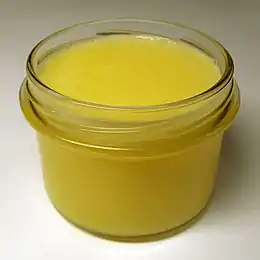Clarified butter
Clarified butter is butter from which all milk solids have been removed. The result is a clear, yellow butter that can be heated to higher temperatures before burning.[1]
 Freshly made clarified butter, still liquid | |
| Place of origin | Worldwide distribution |
|---|---|
| Main ingredients | Butter |
| Variations | Ghee (samneh) |

Typically, it is produced by melting butter and allowing the components to separate by density. The water evaporates, some solids (i.e. whey proteins) float to the surface and are skimmed off, and the remainder of the milk solids (casein) sink to the bottom and are left behind when the butterfat on top is poured off. It can also be separated with a separatory funnel or a gravy fat separator. This butterfat is the clarified butter.
Commercial methods of production also include direct evaporation, but may also be accomplished by decantation and centrifugation followed by vacuum drying; or direct from cream by breaking the emulsion followed by centrifugation.[2]
Properties
Clarified butter has a higher smoke point (252 °C or 486 °F) than regular butter (163–191 °C or 325–376 °F),[3] and is therefore preferred in some cooking applications, such as sautéing. Clarified butter also has a much longer shelf life than fresh butter. It has negligible amounts of lactose and casein and is, therefore, acceptable to most who have a lactose intolerance or casein allergy.[4][5]
Regional variations
In cuisine of the Indian subcontinent, ghee is made by cooking clarified butter longer during the separation process in order to caramelize the milk solids, resulting in a nutty flavor when they are filtered out.[6][7][8][9]
In Yemen, there is a local custom where hot water is added to butter while the milk or whey is still within the butter. This mixture is then placed into a separate vessel where it is brought to a boil. Wheat flour or roasted and ground fenugreek seeds are mixed with roasted wheat kernels, and cooked with the butter on low heat – allowed to simmer. Afterwards, the butter is strained until a clear batch of liquid clarified butter remains.[10] It may be stored in an earthenware container in a cool place, or in a smoked container to impart its flavor.
In Mongolia, ghee or "yellow oil" is widely consumed with traditional milk tea.
See also
- Manteiga-da-terra, a Brazilian clarified butter product
- Niter kibbeh, a seasoned, clarified butter used in Ethiopian cuisine
- Smen, a salted, fermented clarified butter, widely used in North African and Middle Eastern cuisines
- Schmaltz, clarified animal fat
- Dairy product
 Food portal
Food portal
References
- "Clarified butter – Glossary – How to cook". BBC Good Food. Retrieved 2010-06-07.
- Walstra, P. Wouters, J. Geurts, T. (2006). Dairy Science and Technology, CRC Press – Taylor and Francis Group
- Amy Brown, Understanding Food: Principles and Preparation, 5th ed., 2014, ISBN 1133607152, p. 468
- Heid, Markham (22 April 2019). "Is Ghee Healthy? Here's What the Science Says". Time. Retrieved 10 April 2021.
- Abarbanel, Aliza (5 April 2018). "What Is Ghee, the Clarified Butter We Could Eat by the Spoon?". Bon Appétit. Retrieved 10 April 2021.
- Iyer, Raghavan (2008). 660 Curries, p. 21. New York: Workman Publishing. ISBN 978-0-7611-3787-0.
- Jaffrey, Madhur (1982). Madhur Jaffrey's Indian Cooking, p. 211. London: BBC Books. ISBN 0-8120-6548-4.
- Sahni, Julie (1998). Julie Sahni’s Introduction to Indian Cooking, p. 217 under "usli ghee". Berkeley: Ten Speed Press. ISBN 0-89815-976-8.
- Landis, Denise (2003). All About Ghee Archived 2018-01-20 at the Wayback Machine The New York Times – Food Chain
- Badiḥi, Yiḥya (2011). Yosef Ḥen (ed.). Ḥen Ṭov (in Hebrew). Bene Berak: Nosaḥ Teman. p. 206 (responsum no. 48–beth). OCLC 768305430.
.JPG.webp)